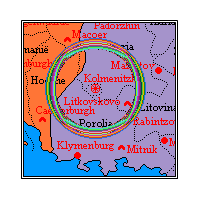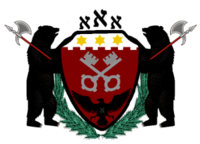Kolmenitzkiy
קולמעניצקי | |
| Nation: | Republic of Ashkenatza |
| Population: | 1,620,000 |
| Predominant language: | Yiddish |
|
| |
| Main roads: | Mamehloshn, Rubinshteiner, Silverstein, Alefbet, Yiddiskeyt |
| Major districts: | Borochov, Nayeshtat, Cher'nivsk, Altshul, Menasseh |
|
| |
| Current mayor: | Herr Pinchas ben Barkat |

| |
| Map versions: | 8.0.1 - current |
Kolmenitzkiy (pronounced kɒlmɛnɪtzkɪ) is the capital city of the Republic of Ashkenatza and its largest city. On both sides of the River Mandel, it is where the country's legislature, the Knesset and where the Nohsi, the Ashkenatzi head of state, resides in Ruzhin Palace. It is also one of the oldest still inhabited cities of Ashkenatza, having developed from a small Shtetl on the riverside in the middle ages. The city has ancient ruins and a great deal of cultural wealth, as well as serving as the economic hub for the Porolia-Volhyria Region. It also serves as the capital of the Kolmenitzkiy Capital Territory, a separate administrative region within Ashkenatza.
The city is served by Kolmenitzkiy Edelmann Airport, and Bar Kochba, Grunwald, Altshuler and Lazarus Central Railway stations. It is a major hub for the Ashkenatzishe Blitsban high-speed rail network. Heavy industry, petrochemicals, aviation technology, pharmaceuticals, metallurgy and tourism have become growing sectors of the economy as of late, alongside the traditional commerce and trading for which the old market city was always known.
Main sights include I.L Peretz Square, home to the Knesset and National Library, Asch Theatre, Pressenstein Castle, Independence Tower, Botanic Gardens, Altshuler Bridge, Tzvi Museum of Antiquities, Ancient Amphiteatre and well-preserved historic Town Centre. The city is divided in two by the River Mandel, spanned by fifteen bridges, the city's oldest district, on the north bank, is on a sharp bend where the river turns towards Volhyria. Defended by the impressive Yabotinsky and Naye-Masada Fortresses, this remains the richest area culturally and is the location of the majority of government ministries and offices. Further to the north across the River lies the district of Grunwald, formerly home to the villas and art-nouveau mansions of the city's growing urban elite. To the North-East lies the Oktagon, a fashionable up-and-coming district regarded as the new cultural heart of the city, itself flanked by the Tellian and Mahozi districts of the city, overshadowed by the Tellian Catholic Cathedral of San Antonio. Further south across the city's canals lies Kolmenitzkiy's river port and markets, over the hill bearing the impressive Mother Ashkenatza Monument. East lies Menasseh, site of the palace of the former Nohsim of Ashkenatza.
Kolmenitzkiy's Southern Bank is more industrialised than the northern half of the city, incorporating the city's airport, petrochemical and heavy engineering industries. Tzur Hill, across the river from Menasseh, is the location of many fine museums and the districts of Nayeshtat (famous for its Protonium and street markets) and Chernivsk, with the Galitzyaner Plats and Chernivsk Grand Synagogue. The Hasidic district of Kerem Ha-Shalom lies to the extreme South-East, and across the railway lines lie Purimsky and Jurek districts, heart of the city's engineering industry. Krelitz, Zmudik, and Mahoz HaKaraim districts are gentrified, University areas known as being isles of green in the bustle of the capital. Yigael, across the river to the West from the city centre, is known for its Jazz scene and riverside embankment.
Institutes of Higher Education in the city include the Ashkenatzi State Technical University, Kolmenitzkiy University of Humanities, Bloom College, Botelli College, The Sznayder Institute and Kolmenitzkiy National University.
Perhaps its biggest claim to fame is that Kolmenitzkiy has one of the largest micronational city maps ever made, at approximately 2800 by 2400 pixels square.
